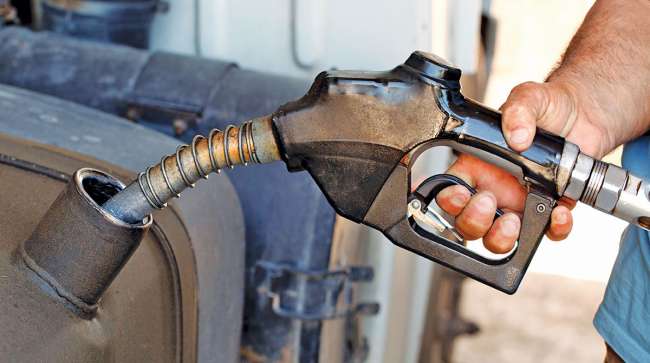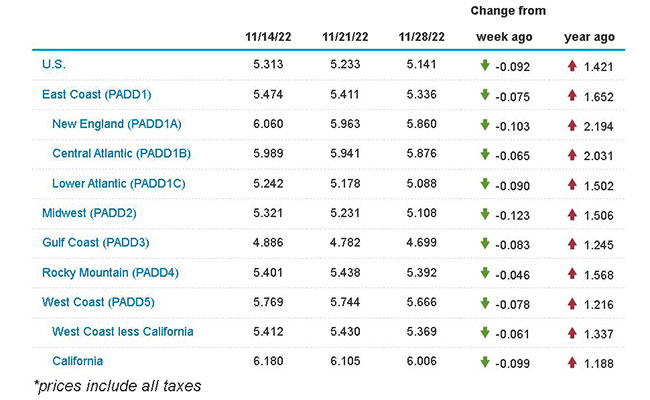Diesel Down 9.2¢ to $5.141 a Gallon

[Stay on top of transportation news: Get TTNews in your inbox.]
The national average price of diesel dropped 9.2 cents to $5.141 a gallon, according to Energy Information Administration data released Nov. 28.
Diesel’s price has shed 17.2 cents over the past two weeks. The current cost reflects the largest drop since a 14.5-cent slide to $4.993 a gallon Aug. 8.
Trucking’s main fuel now costs $1.421 more than it did at this time in 2021.
Diesel’s price went down in all 10 regions in EIA’s weekly survey, with the biggest decline being 12.3 cents in the Midwest and the smallest 4.6 cents in the Rocky Mountain region.
The national average price for a gallon of gasoline tumbled 11.4 cents a gallon, down to $3.534.
U.S. On-Highway Diesel Fuel Prices

EIA.gov
Oil Price Information Service founder Tom Kloza said demand for petroleum products has declined during the past several months, and refineries are making more than an adequate supply of gasoline, diesel and other products to keep up, so he anticipates prices — especially for gas — will continue to drop for the next several months.
“We’re where I thought we’d be on gasoline, we are lower than I thought we would be on crude oil, and we’re about where I thought we’d be on diesel,” Kloza said. “It’s easy to predict what’s going to happen with gasoline; [prices] are going to drop pretty significantly in the next couple of weeks. I think diesel will move a little bit lower, and then it’s all about the weather between Christmas and Valentine’s Day.”

Kloza
Kloza said the weather is especially a factor in the Northeast and Mid-Atlantic, where much of those parts of the country still rely heavily on home heating oil, which from a molecular standpoint is almost identical to diesel fuel.
“The world is still very tight on diesel, and it is probably still factoring in a normal winter,” he said. “Fifty percent of the weather forecasters are suggesting a normal or colder than normal winter, and the other 50% are forecasting a warmer than normal winter. Warm temperatures in the Northern Hemisphere, in the Northeast and Europe could really cause havoc for heating oil profits.”
U.S. average retail prices for November 28, 2022:
— EIA (@EIAgov) November 29, 2022
Regular grade #gasoline: $3.53/gal
On-highway #diesel: $5.14/gal#gasprices https://t.co/dsfxiPAGLR
Kloza said another factor is that with diesel prices still high, refineries are producing more fuel and making a strong profit on that fuel, substantially over the price of gas or unrefined oil, so he believes the oil companies are lowering the price of gas.
“They are making so much money on diesel and jet fuel, which is maybe close to 50% of what they make, that they can sell gasoline for little or no profit,” he said. “You haven’t seen the really sharp price decreases for gasoline that are in the offing; they are coming very, very soon. Prices are going to be dropping very rapidly.”
Meet the truck-driver-turned-writer whose book is helping thousands of everyday people lead with positivity. Then, hear from the philanthropist whose truck-driver-focused charity seeks to ensure that drivers who need help, get it. Tune in above or by going to RoadSigns.ttnews.com.
Meanwhile, after a significant increase in price for the benchmark West Texas Intermediate crude oil, now trading in the $78 per barrel range, that oil is now only slightly higher than its $72 price a year ago. However, WTI steadily climbed through the winter and spring and peaked at $122.11 on June 8, before beginning what has been a steady decline for the past five months. Kloza predicts gasoline will fall to below $3 a gallon within the next 90 days in at least 90% of the nation.
“Deflation for energy prices, gasoline is going to be a compelling story in 2023,” he said.
The Baker-Hughes weekly count of operating oil rigs in the U.S. shows a significant increase in domestic production. As of the week ending Nov. 23, the number of rigs increased by two from the previous week and is up 215 compared with the year-ago period.
According to EIA, domestic oil production for the first 10 months of the year is nearly back to pre-pandemic levels, when in 2019 the U.S. was producing just over 11.8 million barrels per day.
EIA’s latest report says the 10-month average for 2022 is 11.3 million barrels per day, well above 10.9 million per day in 2020 and 10.7 million in 2021, when the pandemic forced millions of drivers to park their cars.
The agency also reported rig counts for 2022 have averaged 696 for the first 10 months of the year, compared with 439 in 2020 and 445 in 2021.
Want more news? Listen to today's daily briefing below or go here for more info:



